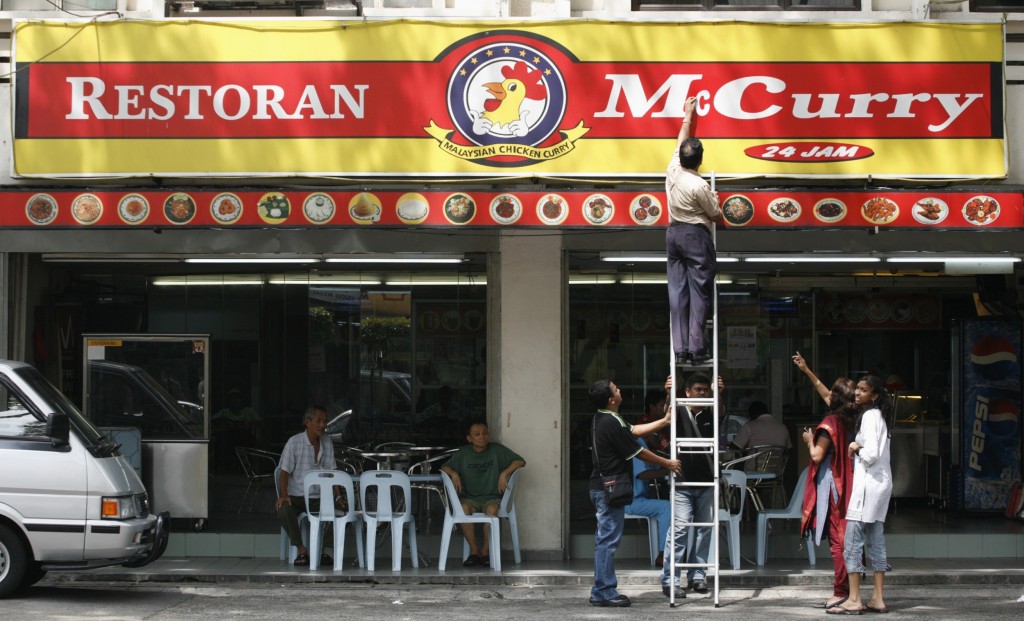The importance of trademark registration has been recently highlighted by a spate of bad-faith registrations, where some Chinese companies have systematically registered the trademarks of foreign companies with the express intention of selling them back at an inflated price.
If you want to protect and enforce your trademark in China, you must first ensure that it is properly registered. In the following article the China IPR SME Helpdesk give a detailed guide on how to do this, and provide comparisons between the international and the Chinese national systems.

McCurry, a Malaysian restaurant, won an epic eight-year trademark battle with McDonalds on the grounds that no one could possibly confuse the two restaurants
It is important to note that China uses the ‘first-to-file’ system, meaning that companies may lose legal protection in China if a similar mark has already been registered here. China is a member of the Paris Convention and WTO, so you ought to file in China within six months of registration of the same mark in Europe in order to keep the original application date.
A trademark must be used by the owner or risk being invalidated. Third parties may request invalidation through non-use if a trademark has not been used “on the goods, packages or containers, or on trading documents, in advertising, an exhibition or any other business activities” for three years after it was granted.
What is a trademark?
A trademark is a sign that serves the specific and primary purpose of identifying the goods or services of a producer, thus allowing the consumers to distinguish goods or services of one producer from those of another.
What can be registered as a trademark?
The sign may be composed of words, devices, letters, numerals, three-dimensional signs (shapes), combinations of colours or any combination of the above.
Trademarks in Chinese
If one does not exist, Chinese consumers are likely to find a Chinese name for foreign trademarks, so it is advisable to register a Chinese version of a foreign trademark to at least prevent an undesirable name or meaning from being assigned to your brand. Registration of a trademark in roman characters does not automatically protect the trademark against the use or registration of the same or similar trademark written in Chinese.
Registration procedure
A trademark can be registered either through the ‘national system’ by direct application to China’s Trademark office (TMO) or through the ‘international system’ by application to the World Intellectual Property Organisation (WIPO).
National System
Make sure you select a trademark agent from the official list. The involvement of a trademark agent for the filing of the trademarks at the TMO is advisable for all companies and mandatory for foreigners without residence or place of business in China. National applications can only be made in Chinese.
International System
Upon receipt of the application for extension of protection, the WIPO issues a certificate, publishes the trademark in the International Trademark Gazette and notifies the trademark authority of the state concerned. International applications may cover more than one country at the same time and at the same cost, and the basic fee covers up to three classes of goods and/or services, and registration is normally processed faster than national registration. International trademarks are protected for 10 years and a renewable period of 20 years.
Comparisons: National vs. International Registration System
- In practice, both are valid for ten years.
- International applications may be made in English, French or Spanish; national applications can only be made in Chinese. Foreign companies must use a Chinese trademark attorney and have a Chinese company name and address.
- The fee for international applications covers multiple countries consecutively and up to three classes of goods or services; for the national system a separate application must be completed per class.
- No theoretical difference between international and national trademark registration, but practically it may be better to apply through the national system—you will be provided with a Chinese language certificate which can be used when undertaking any enforcement action in China and can accelerate proceedings when dealing with local authorities. You can request a Chinese language certificate through the international system from the TMO to certify an international trademark, but this can take up to three months.
- Both systems use the International Classification of Goods and Services under the Nice Agreement; Chinese classes also include sub-classes which are not widely used in Europe.
- Broader specifications are acceptable for international applications; national applications need to be more specific.
Trademark Certificate
It is necessary in China to request the TMO to certify an international registration, which may take up to three months, thereby affecting the speed of an enforcement action. Chinese trademark agents usually provide a watch service for their clients. It is highly recommended that this service, as well as the assessment and advice regarding the possibility to oppose, be entrusted to Chinese speaking professionals and conducted in Chinese, as some infringing trademarks that should be opposed may be in Chinese.
The China IPR SME Helpdesk is a European Commission funded project that provides free, practical, business advice relating to China IPR to European SMEs. To learn about any aspect of intellectual property rights in China, visit our online portal at www.china-iprhelpdesk.eu. For free expert advice on China IPR for your business, e-mail your questions to: question@china-iprhelpdesk.eu. You will receive a reply from one of the Helpdesk experts within seven working days. The China IPR SME Helpdesk is jointly implemented by DEVELOPMENT Solutions and the European Union Chamber of Commerce in China.



Recent Comments